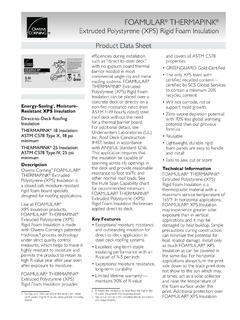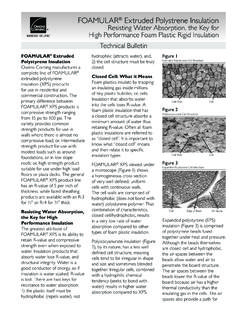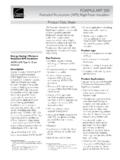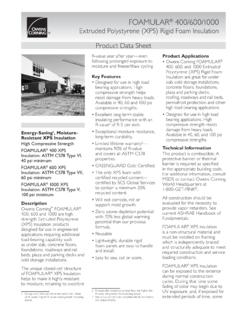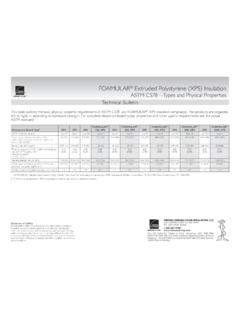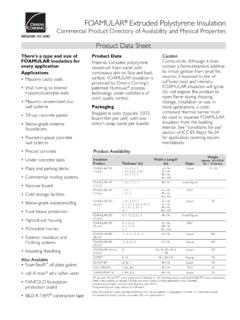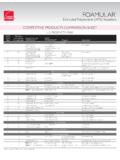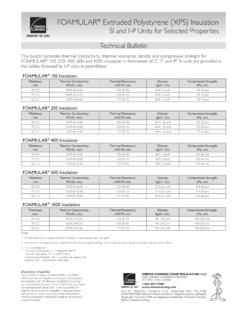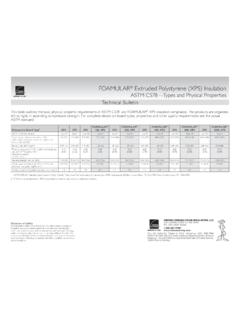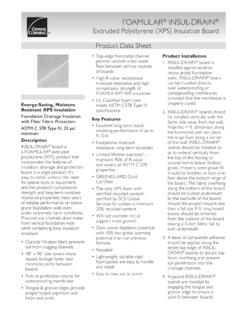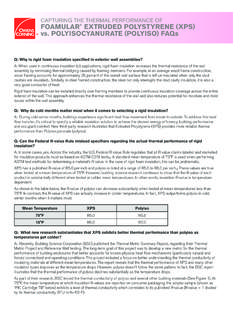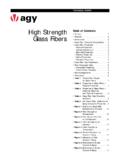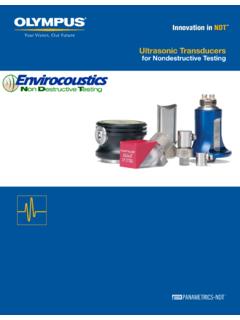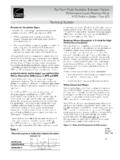Transcription of For Foam Plastic Insulation, Extrusion Matters …
1 For foam Plastic insulation , Extrusion Matters performance Equals Resisting Water XPS Performs Better Than EPS. Technical Bulletin Polystyrene insulation Types in lost insulation power (R-value). Lost R-value results in There are two types of rigid polystyrene foam Plastic reduced performance . The industry standards separate insulation , extruded (XPS), and expanded (EPS). EPS and XPS types so that important physical property differences like water absorption can be identified for XPS is manufactured in a continuous Extrusion specifications purposes. See Table 1. process that produces a homogeneous closed cell cross section (Fig 1). Resisting Water Absorption is Critical for High performance insulation EPS is manufactured by expanding spherical beads in a Over the lifetime of a building or paved surface water mold, using heat and pressure to fuse the beads gets into, and lingers in, the soil around the construction.
2 Together where they touch, leaving open spaces Therefore, where the purpose of the insulation is between the beads where they don't touch (Fig. 2). to insulate, the most important characteristic of the insulation is its ability to retain R-value and continue to Although both types are comprised of polystyrene, the insulate even when exposed to water for long periods two types of manufacturing processes produce finished of time. Water is an excellent conductor of heat, so if products with very different performance properties. Of insulation is water soaked, R-value is lost. If absorbed the two types, EPS absorbs more water in laboratory water freezes and thaws the insulation structure will tests and in application resulting in reduced performance . breakdown over time and structural integrity can be This bulletin explains the important difference between compromised.
3 XPS and EPS and demonstrates that Extrusion Matters . There are two keys to resisting water absorption: AASHTO M230, ASTM D6817 and ASTM C578: The Plastic itself must be hydrophobic (repels water), Water Absorption Differences in XPS and EPS not hydrophilic (attracts water), and, These widely used industry standards define rigid polystyrene insulation . The standards are the basis of The cell structure must be continuous and closed. design for a variety of construction insulation applications for both building and geo-technical polystyrene foam or What Closed Cell Means geofoam . Some specifications are written to require compliance with AASHTO M230 except the Extrusion process is Both XPS and EPS are manufactured to meet the not required . Actually, the Extrusion process is the physical property specifications in ASTM C5781, most important difference between EPS and XPS and ASTM D68715 and AASHTO M2302.
4 For any type of it results in one of the most important performance construction it is important that the rigid insulation differences which is water absorption. chosen for use possess properties that are suitable for the application. That is particularly critical when rigid Both XPS and EPS are manufactured using polystyrene insulation will be exposed to water as in protected which is a hydrophobic polymer that repels water. The membrane roofing, or below grade uses including big difference that causes EPS to absorb more water than foundations, frost protected shallow foundations, and XPS is a result of the manufacturing process. The XPS. geotechnical applications such as under pavement and continuous Extrusion process produces a homogeneous lightweight fill replacement. closed cell matrix with each cell fully enclosed by polystyrene walls.
5 The EPS bead molding process, The most important difference between EPS and XPS although individual beads are closed cell, leaves open is the amount of water absorbed by each. Although voids between beads where water enters. some EPS manufacturers attempt to disguise it, EPS. absorbs more water than XPS. Absorbed water results Figure 1: Extruded Polystyrene Cell Structure Cell Wall Table 1. (No spaces Water Absorption as Defined by Industry Standards between cells). (volume %). XPS EPS Difference Cell ASTM C578 to 10 -13 X. AASHTO M230 10 X. Does not address water absorption ASTM D6817. or thermal performance For foam Plastic insulation , Extrusion Matters performance Equals Resisting Water XPS Performs Better Than EPS. Technical Bulletin Figure 2: Expanded Polystyrene Cell Structure happens if only a partial area of EPS insulation is exposed to water?
6 The answer is, EPS wicks water into its open void structure even when only a small surface area is Bead Cells exposed to water. Edge of Bead To demonstrate, columns of colored water were sealed over a small surface area of three different densities of Water Absorbing EPS (See Fig. 4a). With only a small surface area of EPS. Void Space exposed to the water column, the colored water Between Beads traveled by capillary action through voids in the EPS then wicked throughout the entire sample (See Fig. 4b). Using the same method, FOAMULAR XPS showed no water movement into or through its closed cell structure Compare XPS (Fig. 1) to EPS (Fig. 2). Because of the neither by capillary action nor wicking. This demonstration homogeneous cross section of XPS, very little water is shows the important water absorption differences that absorbed into the cell structure.
7 Closed cell means result from the EPS bead expansion process compared to very little R-value reducing water will be absorbed into the XPS Extrusion process. the insulation board. The XPS Extrusion process Figure 4a: EPS Water Absorption via Wicking produces that closed cell structure. The EPS expansion process does not, therefore, EPS should be considered an open void structure. Closed Cell versus Open Cell: The Impact on Water Absorption Both ASTM C578 and AASHTO M230 require that polystyrene insulation be tested for water absorption in accordance with ASTM C2723. C272 requires the sample to be fully immersed in water for 24 hours, and weighed immediately upon removal from immersion to determine the amount of absorbed water. Figure 3 shows the dramatically higher EPS water absorption rate when tested in accordance with the industry mandated standard.
8 Figure 4b: EPS Water Absorption via Wicking Figure 3: XPS and EPS Water Absorption Compared Tested in accordance with ASTM C272. EPS Water Absorption via Capillary Action The Effect of Water Absorption on R-Value and Wicking It has been demonstrated that EPS absorbs significantly Although industry standards require that water more water than XPS. Although the individual beads of absorption be measured after full immersion, what EPS are closed cell, the voids between the beads absorb happens if EPS boards are not fully immersed? What significant amounts of water, which reduces the already For foam Plastic insulation , Extrusion Matters performance Equals Resisting Water XPS Performs Better Than EPS. Technical Bulletin lower in-service R-value of EPS compared to XPS. How Fig. 6b: EPS Type IX, ASTM C578 (Sample 71).
9 Much R-value does EPS lose after it absorbs water? To measure R-value after water absorption samples of EPS. were half-submerged in a tray of water for three weeks. R-Value Down (See EPS representative samples in Fig. 5. Tested samples were the standard size for thermal testing, 12 x 12.). Figure 5: EPS Water Absorption and R-Value Samples Water Absorption Up Fig. 6c: EPS Type XIV, ASTM C578 (Sample 72). R-Value Down EPS Sample ID: Sample 70 is ASTM C578 Type II, density pcf; 71 was identified as Type IX by its manufacturer, but measured pcf which is a high density version of Type II; 72 is Type XIV, pcf; 73 is Type XV, pcf Water Absorption The samples were periodically removed from the water Up tray and weighed to determine the amount of water absorbed, and to measure the R-value of the wet EPS.
10 Sample. For each EPS sample the results show significant Fig. 6d: EPS Type XV, ASTM C578 (Sample 73). water absorption during the first week, continuing water absorption in subsequent weeks, and a corresponding loss of R-value due to the intrusion of highly conductive water into the open voids of the EPS. In three of the R-Value four EPS samples note that over the extended test time Down the amount of water absorbed exceeded the maximum allowed by industry standards. This demonstrates that long term exposure to water and the resulting absorption is a concern regardless of manufacturer claims to the contrary. (See Figures 6a through 6d) Water Absorption Up Figure 6: EPS Water Absorption and R-Value Loss Fig. 6a: EPS Type II, ASTM C578 (Sample 70). Fig. 6e: FOAMULAR 250 XPS, Type IV, ASTM C578.
